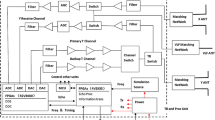Summary
In the field of the exploration of the Solar System NASA and ESA have jointly planned two cornerstone missions whose aim is the close observation of two largely unknown planetary bodies: Titan (Cassini mission) and comet nuclei (Rosetta mission). Our attention in this paper will be devoted to the first one, however some results of this study can be applied also to the second one. Titan is one of Saturn’s moons and is characterized by the presence of a dense atmosphere, opaque for optical sensors. Therefore radar data are the only ones at least theoretically capable of giving relatively detailed informations about the geomorphologic structure of Titan. As a matter of fact the radar cross-section depends on both the dielectric constant of the target by means of the Fresnel reflectivity and on its surface roughness. Moreover if the attenuation is sufficiently low, the radar in principle could be able to detect subsurface discontinuities as well. The above considerations hold true only if a well-suited analytical model accounting for surface backscattering is known. All throughout this paper the radar cross-section of planetary bodies will be evaluated in the case of high-resolution radars.
Similar content being viewed by others
References
D. O. Muhleman, A. W. Grossman, B. J. Butler andM. A. Slade:Radar Reflectivity of Titan, Science, Vol.248, May 1990, pp. 975–980.
W. R. Thompson andS. W. Squyres:Icarus,86, 336 (1990).
J. I. Lunine andB. Rizk:Icarus,80, 370 (1989).
J. I. Lunine:Icarus,81, 1 (1989).
N. Dubouloz et al.:Icarus,82, 81 (1989).
D. M. Hunten et al.:Titan, inSaturn, edited byT. Gehrels andM. S. Mattews (University of Arizona Press, Tucson, 1984).
J. L. Lunine andD. J. Stevenson:Evolution of Titan’s coupled ocean-atmosphere system and interaction of ocean with bedrock, inIces in the Solar System, edited by Klinger (1984).
A. K. Fung andM. J. Eom:IEEE Trans. Antennas Propag.,31, 68 (1983).
F. T. Ulaby, R. K. Moore andA. K. Fung:Microwave Remote Sensing (Addison- Wesley Publishing Company, 1981).
Author information
Authors and Affiliations
Additional information
The authors are indebted to P. T. Melacci of the Dipartimento di Fisica, Univesità di Perugia, for his valuable help. This work has been partially supported by ASI, the Italian Space Agency, contract n. 1991 RS23.
Rights and permissions
About this article
Cite this article
Picardi, G., Seu, R., Coradini, A. et al. The radar system for the exploration of Titan. Nouv Cim C 15, 1149–1161 (1992). https://doi.org/10.1007/BF02506709
Received:
Issue Date:
DOI: https://doi.org/10.1007/BF02506709




